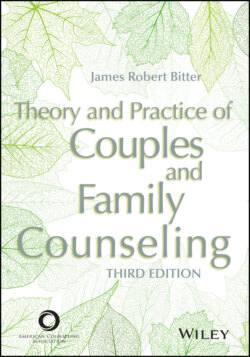Читать книгу Theory and Practice of Couples and Family Counseling - James Robert Bitter - Страница 71
The Process of Change and Therapeutic Process
ОглавлениеIn one sense, change is inevitable: It is life. From the moment we are conceived until long after we die, we change. Where there is no change, there is simply no life. Change is also something that happens both internally and externally. When we talk about changing internally, we are considering the human capacities for adapting, adjusting, and taking a different stance. But change also happens in the world, and it has real effects on the lives of people. External change and its effects may be easiest to see in natural disasters when, for example, certain structures or places we have come to know and trust are simply wiped out of existence (as in a tornado or a hurricane). In families, losing a job, divorcing, adding children, moving to a new location, starting school, and leaving home are all examples of changes that affect the family and its members.
Each of the models we will study approaches the process of change somewhat differently. All of them contribute something to an understanding of how change occurs and how people adapt to changes in their lives. For now, however, let me use Satir’s description of the process of change to orient us to what can happen in family counseling. Satir believed that the patterns and routines people create to make their lives functional achieve a kind of normalcy she called the family’s status quo. People tend to stay in their patterns and routines until their lives are disrupted by an outside force she called a foreign element. It is the disruption of our patterns and routines that sends both the family and its members into chaos, the feeling that comes with being disoriented and unable to focus. In chaos, everything seems overwhelming, unsafe, and out of balance. If people are able to regain a sense of balance and safety, if they are able to right themselves and feel their feet back on the ground, they often are able to create or discover new possibilities, to change course, or to adapt. Whatever works will, over time, become a new integration, a new set of patterns and routines, and a new status quo (Pelonis, 2002; Satir & Baldwin, 1983; Satir et al., 1991).
Of course, family practitioners tend to meet families when they are in chaos. The family may want to make major decisions in an effort to reduce the pain of the problems they face, but this is usually a mistake. In the beginning, exploration is usually a much more important intervention than problem-solving. Discovering who the people are and why they are seeking help provides focus as well as goals for counseling. I believe the single most important thing that you can do when a family is in chaos is stay present and listen. The first tasks of family practice are almost always to form a relationship with the family and begin an assessment. Monica McGoldrick (2016), for example, is highly effective at using genograms as an avenue to forming an exploratory relationship with couples and families (see McGoldrick, 2018).
Although the ultimate end of counseling may be the facilitation of change, each model will have different ways of achieving that end. In the chapters that follow, you will read about change processes that involve coaching, nurturing, sculpting, educating, experiencing, enacting, directing and indirecting, focusing on solutions, coconstructing preferred outcomes, and even training for more effective living. Almost none of the models we will study advocate change for the sake of change. The ends these approaches seek may be varied in description and process, but there are some general guidelines:
It is better for families to rediscover their connections than to be left in disarray and disengagement.
It is better to remove constrictions from systems and allow people to experience life more fully than to leave them in protective states.
It is better for systems to be organized than disorganized.
It is better for communication to be open, congruent, and responsive than to be closed, defensive, or dismissive.
It is better to say what we think and feel about things that matter than to be lost in silence.
It is better to set limits, define a bottom line, and clarify what we can do and give than to be controlled by others.
It is better for people to think rationally than irrationally.
It is better to know than not to know.
It is better for people to feel something than to feel nothing at all.
It is better for people to act and take a chance than to become immobilized or constricted.
It is better to have goals and hope than to be discouraged.
It is better to have access to a greater number of internal parts than just a few.
It is better to be appreciative of one’s gender, culture, and ethnicity than to reject it or be cut off from it.
It is better for people to risk optimism, faith, and courage than to live in fear.
Of course, there are exceptions to every one of these generalities. But taken together, they point toward growth, development, organization, meaningfulness, increased opportunities, wider and varied experiences, and augmented capacities and strengths. Which of these guidelines might inform your goals in working with families? Are there additional guidelines you could offer? Are there some that do not fit for you at all? Envisioning where you are going with a family is essential to getting there.
